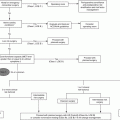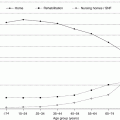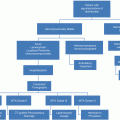Phases
Host (individual)
Agent (motor vehicle)
Environment
Pre-event (will event occur)
Age, gender, medications, alcohol use, vision, fatigue, ambulatory aids/ability
Speed, size, ability of driver, brakes
Road design, crosswalk design and timing, weather conditions, visibility, speed restrictions, traffic restrictions
Event (will injury occur)
Age, preexisting conditions (e.g., osteoporosis), medications (e.g., bleeding risk)
Speed, size, brakes
Site of crash, landing zone
Post-event (will consequence occur)
Age, comorbid conditions
Ability to extricate
Availability of EMS, distance from emergency care, quality of trauma system and rehabilitation
Advanced age is a well-recognized risk factor for morbidity and mortality after trauma [7]. There are many systems-based age-related physiologic changes that have been detailed in the previous chapters that will not be reviewed here, but all play an important role in the decreased physiologic reserve of the elderly trauma patient. They also play a role in increasing the risk of the traumatic event occurring (e.g., deteriorating sight, poor coordination). In general, older adults have more preexisting medical conditions which increase their risk of mortality and are frailer causing more severe injury in response to a given injury [8].
Although the elderly are a special population, the trimodal distribution of traumatic deaths still applies. It states that deaths due to injury occurs in one of three periods [9, 10]. Approximately 50 % of deaths occur within minutes of the injury and are most likely due to severe neurologic (brain, high spinal cord) injury or massive hemorrhage due to rupture of the heart or large blood vessel. These individuals cannot be saved due to the severity of their injuries even in the most mature trauma and EMS systems, and efforts at preventing the occurrence will be effective in reducing this peak of trauma-related deaths. The second peak occurs within minutes to several hours and is usually due to subdural or epidural hematomas or injuries associated with significant blood loss (e.g., splenic or liver laceration, pelvic fractures). These patients require rapid assessment and resuscitation. The third peak occurs several days to weeks, most likely due to sepsis or multisystem organ failure. Efforts at reducing the severity of injury once it has occurred will impact the two later peaks of trauma-related deaths.
Overview of Injury
Unintentional injury is the fifth leading cause of death over all age groups, both sexes, and all races in the United States (which excludes suicides and homicides) [11]. In patients aged 65 or greater, trauma is the seventh leading cause of death. In 2009, over 44,000 people aged 65 or older died from injuries in the United States, which is an average of 120 persons each day or 1 person every 12 min [12]. In those aged 65 years or greater, the leading mechanisms of injury, in rank order, are as follows: falls, motor vehicle crashes, and suicides.
Although the total number of traumatic injuries in the elderly is less than the total number of traumatic injuries in those younger than 45 years of age, the rate (or risk) of injury per age group is just the opposite. The elderly aged 65 and older are at the highest risk of fatal injuries, a risk that increases with each year of age. Using 2010 data, the rate of injury death in 65–74 year olds was 60 per 100,000 population, for persons aged 75–84 it was 124.7 per 100,000 population, and for those 85 and older it was 350 per 100,000 population, which compares to 58 per 100,000 in the general population [13]. The elderly that are older than 65 comprise 13 % of the US population, but account for 33 % of all injury deaths and 32 % of injury-related hospitalizations. The US population continues to age, with those over 65 years of age estimated to be 20 % of the population by 2030 [5]. This has profound implications on health and trauma care with the burden of geriatric injury surely increasing with the aging US population.
Mortality is not the only potential result of a traumatic event. Particularly in the elderly population, the morbidity can be just as serious a complication and have widespread personal, family, and societal repercussions including decreased quality of life and high costs of immediate and long-term medical care. Each year, over 760,000 people older than 65 are hospitalized as the consequence of a traumatic event, while over 2.7 million are treated in the emergency department and released. In this same group, the leading causes of nonfatal injuries are, in rank order, as follows: falls, assault, unintentional overexertion, and motor vehicle crashes. Total lifetime costs associated with nonfatal injuries in those aged 65–85 occurring in the year 2005 amount to over $18.5 billion. The costs for nonfatal injuries include direct medical expenditures as well as the value of lost work productivity, but do not include the cost of pain, reduced quality of life, or the reduced quantity of life.
Injury by Mechanism and Intent
Traumatic injuries are classified by their mechanism, their intent, and the place of injury. Mechanism refers to the external agent or activity that caused the injury (e.g., fall, motor vehicle crash, stab wound). Intent is classified as unintentional, intentionally inflicted by someone, or undetermined. The place of injury can be classified as urban, suburban, and rural as well as location in the country.
Falls
Falls are the most common mechanism of fatal injury in the elderly, responsible for 52 % of unintentional injuries in 2009. Falls are also the most common cause of nonfatal injury in the elderly resulting in over 2.2 million emergency department visits and over 580,000 hospitalizations in the year 2009 [13]. In the United States, each year more than 1/3 of individuals over the age of 65 will experience a fall, this increases to 50 % in those who live in an institution [14, 15]. Half of those who do suffer a fall will have at least one more unintentional fall in the next 12 months [16]. Of these, 25 % will be injured and another 25 % will restrict their daily activities for fear of falling [17, 18].
In 2009, 82 % of fall-related deaths were among those aged 65 and older. The rate of falling and becoming injured increases with age. The rate of fall injuries for adults over the age of 85 is four times the rate for adults aged 65–74. Women are 58 % more likely than men to suffer a nonfatal fall injury, with fall-related fractures twice as likely in females than in males. White females are twice as likely as black females to suffer a hip fracture. Up to 30 % of the elderly will suffer a moderate to severe injury such as a laceration, hip fracture, or head injury [17].
Falls are the most common cause of traumatic brain injuries in the geriatric population. In 2000, 46 % of deaths from same height falls in elderly adults were the result of a TBI [19]. Falling from standing is associated with a hip fracture in 5 % of individuals, a risk that increases with age [20]. One half of those who suffer a hip fracture are no longer able to live independently.
Major risk factors for falls among the elderly include those related to the host: advanced age, history of previous falls, hypotension, psychoactive medications, dementia, difficulty with postural stability and gait, visual, cognitive, neurologic, and physical impairments. Environment factors include the following: loose rugs, objects on the floor, ice/slippery surfaces, uneven floors, poor lighting, and stairs without handrails. The risk of falling increases linearly with each additional environmental factor present [20].
Motor Vehicle Crashes
There are 32 million licensed older drivers in the United States [21], 15 % of all drivers. Motor vehicle crashes are the second most common mechanism of fatal injury in persons aged 65 or older, responsible for 34 % of unintentional deaths in 2007 [12] and causing over 170,000 nonfatal injuries (5 % of total nonfatal injuries) in the elderly [13]. These older individuals made up 16 % of all traffic fatalities and 8 % of all people injured in traffic crashes during the year [21].
Although those over the age of 75 have a high risk of dying from their injuries, those in their teens and twenties are actually at the highest risk of fatal and nonfatal injuries due to MVC [22]. However, excluding teens and young adults, drivers older than 85 have a fatality rate that is 7–9 times greater than that of young drivers. In two-vehicle fatal crashes involving an older driver and a younger driver, the vehicle driven by the elder was 1.7 times more likely to be the one that was struck (58 % and 34 %, respectively). In 46 % of these crashes, both vehicles were proceeding straight at the time of the collision. In 24 %, the older driver was turning left—four times more often than the younger driver [21].
In general, older people drive less total miles, less at night, on more familiar roads, and at lower speed limits which results in a majority of elderly traffic fatalities occurring in the daytime (81 %), on weekdays (71 %), and involving other vehicles (69 %) [21].
Injury patterns in the elderly are similar to those that are seen in the general blunt trauma population. Risk factors in the elderly that may contribute to motor vehicle crashes include a larger blind spot (secondary to decreased peripheral vision), limited cervical mobility, slower reaction times, poorer technique for merging into traffic, decreased hearing, and cognitive impairment. Moreover, chronic medical conditions such as dysrhythmias, hypoglycemia (diabetes-related complications), and thromboembolic events such as stroke or myocardial infarction may be the precipitate event resulting in an accident. As with any driver, alcohol and impaired function lead to an increased risk for a crash. Compared to all drivers, older drivers involved in fatal crashes are the least likely to be legally intoxicated defined as a blood alcohol concentration of .08 g/dL or higher (5 % vs. 22 %, respectively) [21].
Major factors contributing to the likelihood of a crash include vehicle speed, vehicle stability, braking deficiencies, inadequate road design, and driver alcohol intoxication. When a collision does occur, important determinants of the likelihood of an injury and its severity include speed at impact, vehicle safety, and the use of restraints. Seventy-nine percent of all older occupants of passenger vehicles involved in fatal crashes were using restraints at the time, compared to 64 % for other adult occupants (18–64 years old) [21].
Pedestrians Hit by Motor Vehicles
In 2009, a total of 4,092 pedestrians were killed, and an estimated 59,000 were injured by vehicles in the United States. In 2009, the fatality rate for older pedestrians (age 65+) was 1.96 per 100,000 population—higher than the rate for all the other ages. On average, a pedestrian was killed every two hours and injured every nine minutes by a motor vehicle. Pedestrian deaths accounted for 12 % of all traffic fatalities and made up 3 % of all the injuries related to traffic crashes. Older pedestrians (age 65+) accounted for 19 % of all pedestrian fatalities and an estimated 8 % of all pedestrians were injured in 2009 [23]. Moreover, as the pedestrians aged, the risk of mortality increases from a rate of 1.75 per 100,000 population for those aged 65–74 to a rate of 2.29 for those aged 75–84 [12]. Distribution by gender demonstrated that 61 % of elderly pedestrians killed in 2009 were males, with a fatality injury rate of 2.51 per 100,000 compared to 1.33 per 100,000 in females. The male geriatric pedestrian nonfatal rate per 100,000 population was 18 %, twice the rate of 9 % for females.
Stay updated, free articles. Join our Telegram channel

Full access? Get Clinical Tree







